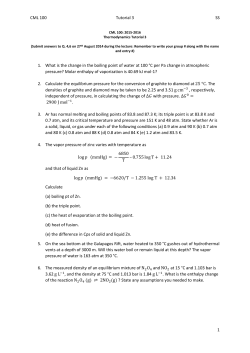
Document 276179
Name Period Chemistry Gases Review Date idy all notes, homework problems, daily questions. Equations, constants, conversion factors and vapor pressures of water will be given on the test. I . A 4.00 L sample of gas at 720 mmHg pressure is changed at constant temperature until its pressure is 125 kPa. What is its new volume? To what pressure must a sample of gas be subjected at constant temperature in order to compress it from 550 mL to 335 mL if its original pressure is 2.11 atm? What are the freezing point and boiling point of water (a) in Celsius, (b) in Fahrenheit, and (c) Kelvin? A 6.50 L sample of gas is warmed at constant pressure from 28°C to 225°C. What is its final volume? A gas at 56 kPa is warmed from 440°C to 535°C. What is the final pressure if the volume of the container remains constant? A sample of gas is pumped from a l 0.0 L vessel at 127°C and 834 mmHg to a 3.5 L vessel at 52°C. What is its final pressure? A sample of gas occupies a volume of 13.5 L at 22°C and 1.25 atm pressure. What is the volume of this sample at STP? A sample of gas occupies 4.18 L. What will be its new volume if its pressure is doubled at constant temperature? 9. Calculate the missing value for each set of data in the following table: P1 VI T1 P2 V2 a 1.00 atm 4.00 L 273 K 1.00 atm 2.00 L b 7.00 atm 333 K 3.10 atm 6.00 L 444 K c 1.00 atm 5.43 L 130°C d e 12.0 atm f 721 mmHg T2 3.65 L 130°C 29.1 L 45°C 780 mmHg 2.22 L 77°C 28°C 12.0 atm 750 mL 53°C 1.21 atm 0.850 L 100°C 200 mL How can you recognize an ideal gas law problem? What is the value of R, the gas law constant? 12. Calculate the pressure of 1.88 mol of a gas that occupies 29.0 L at 47°C. . Calculate the temperature in °C of 0.250 mol of a gas that occupies 10.0 L at 86.7 kPa. 14. Calculate the value of the constant, R, in the ideal gas equation. Assume 1.00 mole of gas at STP (0°C, 1.00 atm). Be sure to include the proper units. Which gas effuses faster: Helium (He) or chlorine (Cl 2 )? How much faster? If it takes helium atoms 125 seconds to effuse through a small hole, how long will it take for chlorine to effuse? Air contains a mixture of 02, N2, CO2, and argon. What is the partial pressure of 02 if atmospheric pressure is 1.00 atm, P(N 2 )=597.4 mmHg, P(CO 2 )=0.350 mmHg, P(Ar)=7.2 mmHg. A 5.50 L tank contains 22.8g H2 and 434g Ar @ 15.0°C. (a) Determine the total pressure of the mixture. (b) Determine the partial pressure of argon. (c) Determine the mol fraction of hydrogen. Define or explain the following: temperature, pressure, atmospheric pressure, Avogadro's Hypothesis, Law of combining volumes, diffusion, effusion. Write equations to represent each of the following: Charles' Law, Boyle's Law, Gay-Lussac's Law, Ideal Gas Law, Dalton's Law, Graham's Law, Summarize the four parts of the kinetic theory of gases. Sketch graphs of the relationships between (a) P and V; (b) P and T; (c) V and T. Indicate which law each of these represents. Collisions between ideal gas molecules are a. elastic b. inelastic c. never observed The average kinetic energy of water molecules is greatest in b. water at 90°C c. water at 373 K a. steam at 200°C d. ice at 0°C What instrument is normally used to measure atmospheric pressure? a. thermistor b. barometer c. hydrometer d. spectrometer 1-low does the atmospheric pressure at altitudes below sea level compare with atmospheric pressure at sea level? a. The atmospheric pressure below sea level is higher. h. The atmospheric pressure below sea level is lower. c. The pressure is the same. Standard conditions when working with gases are defined as b. 0 K and 1 mm Hg c. 0°C and 1 atm a. 0 K and 1 atm 27. The pressure of a gas in a container is 152 mm Hg. This is equivalent to b. 2 atm c. 0.3 atm a. 0.2 atm d. 0°C and 1mm Hg d. 0.4 atm
© Copyright 2025





















